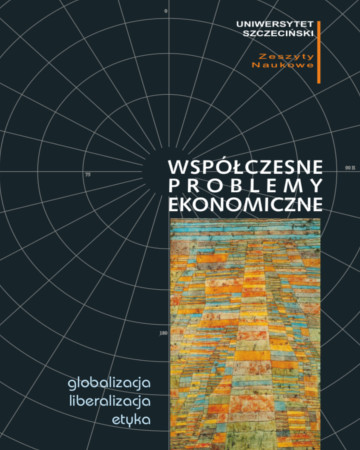
ISSN: 2081-9579
eISSN: 2353-2815
OAI
DOI: 10.18276/wpe.2017.15-01


Issue archive /
nr 15 (2017)
Integracja walutowa jako determinanta synchronizacji cykli koniunkturalnych w strefie euro
(Monetary integration as a determinant of business cycles synchronization in the Euro Area)
| Authors: |
Jan
Borowiec
Uniwersytet Ekonomiczny we Wrocławiu, Katedra Polityki Ekonomicznej i Europejskich Studiów Regionalnych |
| Keywords: | business cycles synchronization euro area monetary integration |
| Data publikacji całości: | 2017 |
| Page range: | 10 (7-16) |
| Klasyfikacja JEL: | E32 E43 F33 |
Abstract
The scientific goal of the paper is to determinate the role of the monetary integration in the business cycles synchronizationin the Euro Area, whereas the methodological goal is to determinate whether selection of the measure of business cycles synchronization and monetary integration significantly changes results of the research. Measures of the business cycles synchronization include: correlation of the output gap, business classical cycles concordance, similarity of macroeconomic shocks and cyclical divergence; measures of monetary integration include membership in the EMU and similarity of monetary policies. Research is based on the simple linear regression model supported by descriptive statistics and correlation analysis. Result of the research suggest that monetary integration fosters the business cycles synchronization in the Euro Area. However regression results are very sensitive to selection of measures of business cycles synchronization.
Download file
Article file
Bibliography
| 1. | Ameco (2016). Pobrano z: http://ec.europa.eu/economy_finance/db_indicators/ameco/index_en.htm. |
| 2. | Barczyk, R., Konopczak, K., Lubiński, M., Marczewski, K. (2010). Synchronizacja wahań koniunkturalnych. Mechanizmy i konsekwencje. Poznań: Wydawnictwo Uniwersytetu Ekonomicznego w Poznaniu. |
| 3. | Baxter, M., King, R.G. (1995). Measuring Business Cycles: Approximate Band-Pass Filters for Economic Time Series. Massachusetts: National Bureau of Economic Reasearch. |
| 4. | Beck, K. (2013). Determinants of Business Cycles Synchronization in the European Union and the Euro Area, „EQUILIBRIUM. Quarterly Journal of Economics and Economic Policy, 8 (4), 25–48. |
| 5. | Burns, A.F., Mitchell, W.C. (1946). Measuring Business Cycles. NBER. |
| 6. | Büwer, U., Guillemineau, C. (2006). Determinants of business cycle synchronization across Euro Area countries. ECB Working Paper Series, no. 587. |
| 7. | Crespo-Cuaresma, J., Fernandez-Amador, O. (2010). Business cycle convergence in EMU: A first look at the moment. University of Innsbruck. FIW Working Paper, 54. |
| 8. | Christiano L., Fitzgerald T. (2003). The Band-Pass Filter. International Economic Review, 44 (2), 435–465. |
| 9. | De Grauwe P., Mongelli F.P. (2005). Endogeneities of Optimum Currency Areas. What Brings Countries Sharing a Single Currency Closer Together? ECB Working Paper Series, 468. |
| 10. | Denis, C., McMorow, K., Röger, W. (2002). Production Function Approach to Calculating Potential |
| 11. | Growth and Output Gaps – Estimates for the Member States and the US, European Commission. European Economy Economic Paper, 176. |
| 12. | European Commission (2015). Cyclical Adjustment Budget Balances. Autumn. Pobrano z: https://ec.europa.eu/info/sites/info/files/file_import/ccab_autumn_en_5.pdf. |
| 13. | Eurostat (2015). Pobrano z: http://ec.europa.eu/eurostat/data/database. |
| 14. | Frankel, J., Rose, K. (1998). The Endogeneity of Optimum Currency Area Criteria. Economic Journal, 108, 1008–2025. |
| 15. | Harding, D., Pagan, A. (2002). Dissecting the Cycle: A Methodological Investigation. Journal of Monetary Economics, 49, (2), 365–381. |
| 16. | Hodrick, R., Prescott, E. (1997). Post-war U.S. Business Cycles: An Empirical Investigation. Journal of Money, Credit and Banking, 29 (1), 1–16. |
| 17. | http://ec.europa.eu/economy_finance/db_indicators/competitiveness/data_section_en.htm. |
| 18. | Mundell, R. (1961). A Theory of Optimum Currency Areas. American Economic Review, 51, 942–963. |